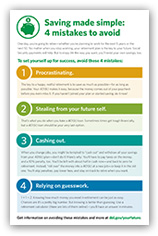
ERISA Advisory Council Hearing to Encourage Lifetime 401(k) Participation: 3 Lessons Learned
We greatly admire the ERISA Advisory Council (EAC) for tackling thorny benefits issues, inviting industry thought leaders to testify before the Council and offer solutions to those issues, then distilling days-worth of testimony into direct recommendations to the Department of Labor (DOL). It’s a major undertaking, so we’re happy to support the EAC whenever possible.
That’s why Jen gladly traveled to Washington, D.C., last week to offer testimony before the Council on how the DOL might create a model notice to encourage retirement plan participants to stay in their plans for the length of their careers—i.e., eliminate or greatly reduce plan rollovers, loans and cashouts.
Since it was Jen’s second time testifying before the EAC (the first, in 2013, addressed simplifying retirement communications overall), we knew we could count on the Council and fellow witnesses to offer key learnings. After a full afternoon discussing lifetime plan participation, here are three lessons we wanted to pass along:
1. Change the end goal (and the terminology along with it). Too often, plan sponsors advise participants to build their “retirement nest egg.” However, building implies that once employees have sufficient savings, the hard work is finished. As benefits pros know, though, managing “retirement income” is a much longer-term proposition. Changing the way we describe retirement in communication can shift the way employees think about retirement, and thus shift their actions. One witness even suggested staying away from the word retirement altogether. “To many workers ‘retirement’ is something their grandparents do, not something that’s for them.”
 2. Create a universal baseline that helps fill in communication gaps. As an advocate of the DOL creating a model notice to encourage lifetime participation, Jen testified that a model notice should be sent to employees at meaningful trigger points in their careers to help fill gaps in employer communication. “A lot of employees only hear about their retirement plan twice: When they start a job and when they leave it,” she said. “So, a baseline communication from the government could be very helpful,” particularly for small employers who lack the resources to produce sophisticated communications that large employers can provide.
2. Create a universal baseline that helps fill in communication gaps. As an advocate of the DOL creating a model notice to encourage lifetime participation, Jen testified that a model notice should be sent to employees at meaningful trigger points in their careers to help fill gaps in employer communication. “A lot of employees only hear about their retirement plan twice: When they start a job and when they leave it,” she said. “So, a baseline communication from the government could be very helpful,” particularly for small employers who lack the resources to produce sophisticated communications that large employers can provide.
3. Tell people what to do—and reinforce that they have to do it. During Jen’s testimony, she walked the EAC members through a sample model notice our team created. It made four simple points: Get in the plan, stay in the plan and keep saving, don’t take your money out, and use a retirement calculator.
While the Council marveled at the piece’s simplicity, Jen emphasized that messaging really does need to be that simple, especially since the retirement lexicon has common terms like investments, asset allocation, rebalancing, and portfolio that are confusing to the average plan participant. “Where there’s confusion, there’s inaction,” Jen said, adding that, “the message, ‘You need to be saving a significant portion of your income consistently in a retirement plan’ is not a message that most employees hear. Letting employees know in clear terms that it’s up to them to save for their future is a huge leap forward from where we are now.”
To inspire your thinking around retirement communications, download Jen’s full testimony and the sample model notice.
Work with Us
We partner with organizations that value their people first. Let’s talk.
